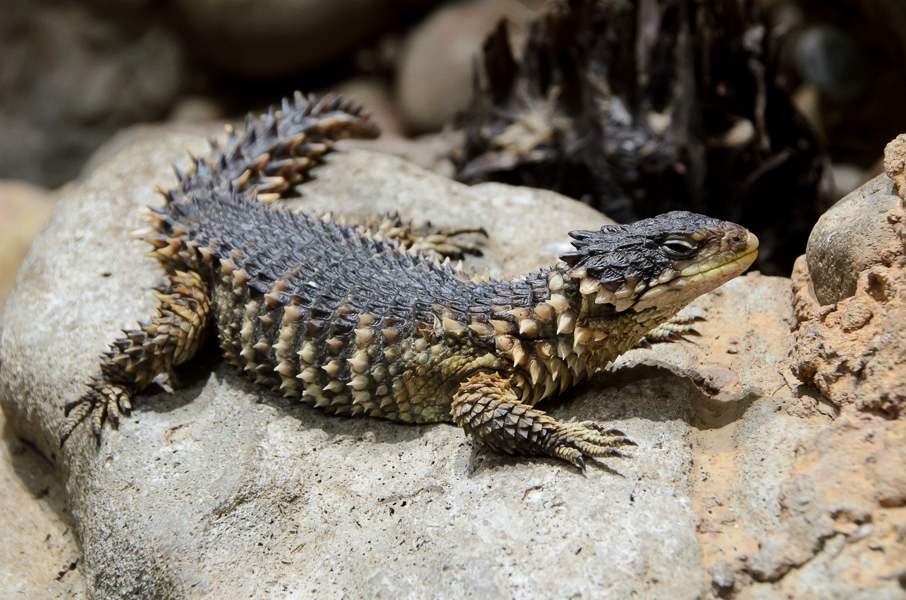Despite the ability to withstand high temperatures within their environment, reptiles depend on access to specific thermal environments to optimise various bodily functions. These include metabolism – converting food to energy – and reproduction. That means significant increases in temperature of the kind being increasingly recorded in many parts of the world could potentially have a negative effect on reptiles.
Although more than 1600 of the 9400 reptile species globally can be found on the African continent, there has been almost no research conducted on the effect of climate change on African reptiles. This is partly because of the evasive nature of many reptile species, and also because funding is limited.
To start filling this knowledge gap, we studied how higher temperatures affect the sungazer lizard (Smaug giganteus). These charismatic reptiles are endemic to South Africa’s highveld. They are already threatened by habitat destruction and illegal collection for the pet and traditional medicine trades. Captive breeding attempts have not worked, which sets the species back further.
We wanted to know what higher temperatures in South Africa will mean for endemic species like the sungazer lizard. Specifically, we wanted to test how being exposed to higher temperatures affected the lizards’ adrenocortical activity as seen in glucocorticoid secretion. Once an animal is exposed to a possible stressor, such as elevated temperatures, the physiological stress response is activated. The animal then secretes more glucocorticoids.
One of this hormone’s primary functions is to provide the required energy and behaviour responses to ensure survival. An elevation in glucocorticoids is adaptive in the short term. But prolonged exposure to elevated levels can have negative effects. These include the suppression of reproductive and immune systems and overall reduced survival. By quantifying an animal’s glucocorticoid levels, scientists can learn crucial information about physiological stress and chances of survival.
 Sungazer lizard/ Image: Flickr
Sungazer lizard/ Image: Flickr
Experiments
Animals’ bodies respond in various ways to stressors like the presence of a predator, an injury, or a change of surroundings. Physiological responses allow an organism to produce sufficient energy or maintain water balance to escape or recover from a stressful situation. A temporary increase in the secretion of glucocorticoids from the adrenal gland is just one form of response.
Once in the bloodstream, glucocorticoids are heavily metabolised in the liver; the hormone metabolites move to the bile before being excreted in faeces. As such, faecal glucocorticoid metabolites can be monitored as a robust proxy for an individual’s adrenocortical activity. Faecal collection also requires almost no direct human-animal interaction, so it’s non-invasive for the animals.
Our research was conducted in a captive environment, at the National Zoological Garden in Pretoria. Because the species is already vulnerable and there aren’t many available to researchers, we only studied four female and two male animals.
At the National Zoological Garden animals are kept at 27℃-30℃, which is thought to be the ideal range for the species. In the wild they will, of course, experience a wider range of temperatures, depending on the season. For now, though, these will rarely reach the 39℃ we used as our high point here.
We divided the animals equally into a control and an experimental group. We let them get used to their new surroundings, at a temperature of 30℃ for two weeks. Control animals were then kept at 30℃ for another six weeks; the experimental group were kept at 39℃ for the same time. Finally, both groups were kept at 30℃ for a further three weeks. Study animals were monitored by conservation staff throughout the study to ensure they were safe and healthy.
We collected faecal samples from all study animals daily and quantified their faecal glucocorticoid metabolites (fGCM). Females kept at constant temperatures showed a constant fGCM pattern throughout the study period. Those subjected to higher temperatures showed a sudden spike in fGCM levels immediately following an increase in temperature, as well as during the return period to 30℃.
The male kept at constant temperatures did not show consistent fGCM levels during the study period. The male exposed to higher temperatures, meanwhile, showed a steady increase in fGCM levels as the study progressed.
These results tell us several things. First, the sudden peak in fGCM levels in test females following temperature manipulations suggests the animals perceived the sudden change in environmental temperatures as a stressor. It activated their physiological stress response to restore homeostasis and ensure survival.
This response in female sungazer lizards may be interpreted positively: it could potentially help them to survive in environments where temperatures rise significantly.
The test male’s story is less positive, as he showed increased adrenocortical activity throughout the study period, even when temperatures returned to 30℃. This could indicate that male sungazer lizards are sensitive to any temperature elevation in their immediate environment, despite only displaying a gradual moderate increase in excreted hormone metabolite levels.
More to understand
We do not want to make substantial inferences, particularly given the small number of lizards we were able to test. But these findings suggest there are sex-specific differences in stress responses within the species – and a potential further threat to sungazer lizard populations likely to be subjected to higher temperatures in future.
Follow-up studies will be needed. For instance, stress responses should be monitored in wild sungazer lizard populations. It’s also important to remember that different species will react differently to climate change, so more reptile species will need to be studied. DM/ML
Dr Robert Campbell, a wildlife veterinarian, co-authored the study this article is based on.
This story was first published in The Conversation.
Juan Scheun is a postdoctoral fellow at the University of South Africa. Andre Ganswindt is a professor and Director of the Mammal Research Institute at the University of Pretoria. Trevor McIntyre is an associate professor in Zoology at the University of South Africa.
[hearken id="daily-maverick/8854"]




 Sungazer lizard/ Image: Flickr
Sungazer lizard/ Image: Flickr